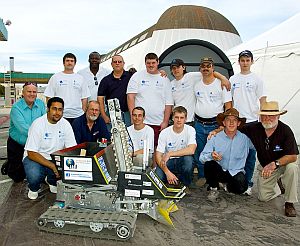 A team of Laurentian University students had high hopes for scooping up the half million-dollar prize at NASA's Regolith Excavation Challenge at the Ames Research Park in Mountain View, California Oct. 16 to 18, but settled for the honour of being the only Canadian team to participate in the annual competition.
A team of Laurentian University students had high hopes for scooping up the half million-dollar prize at NASA's Regolith Excavation Challenge at the Ames Research Park in Mountain View, California Oct. 16 to 18, but settled for the honour of being the only Canadian team to participate in the annual competition.
Led by Dr. Greg Baiden, a professor at Laurentian's School of Engineering and director of Sudbury-based Penguin Automated Systems Inc., the team entered the competition with a teleoperated excavator designed to scoop up lunar dirt from a control centre on Earth.
The Laurentian excavator succeeded in collecting simulated regolith, but the material was sticky and wouldn't dump, said Baiden following the competition.
In order to finish in the money, teams were required to move and dump a minimum of 330 pounds of material in 30 minutes.
Paul's Robotics, a team led by college student, Paul Ventimiglia of Worcester Polytechnic Institute in Massachusetts, won the $500,000 first prize. The second and third place prizes of $150,000 and $100,000 were won by Terra Engineering of Gardena, California and Team Braundo of Rancho Palos Verdes, California. This is the first time in the competition's three-year history that any team qualified for a cash prize.
The winning excavator lifted 1,103 pounds of material within the allotted time. The runners-up excavated 595 pounds and 580 pounds, respectively. Nineteen teams competed in the event.
Tough competition
"This was an incredibly tough competition, and teams came up with fantastic ideas, some of which might find use in future missions to the Moon," said Greg Schmidt, deputy director of the NASA Lunar Science Institute at Ames. "It's great to have a winner this year. The biggest win is getting so many talented young people involved in NASA's mission of exploration."Until this year, said Baiden, the rules for the competition stipulated that the robotic excavators had to operate autonomously.
"This year, they decided to change the rules and allow teleoperation and telerobotics into the competition because the challenge of digging lunar regolith was just too difficult without operator intervention.
"A group of people who knew the reputation I had from doing all this work at the university and at Inco over the years asked me if I would build a robot to put in the competition."
According to Baiden, Canadians aren't officially allowed to compete in the NASA Regolith Excavation Challenge, so the team competed through Penguin ASI's U.S. subsidiary.
The Laurentian excavator features a snowplow-like blade and a bucket-wheel system that transfers the material to a conveyor and ultimately to a box that lifts up and dumps it into a hopper on a regolith processor. Extra wide, individually controlled tracks provide traction and forward thrust to compensate for the Moon's one-sixth gravity. Carbide tip spikes in the tracks are designed to churn up the regolith to make it easier to collect.
The excavator is operated remotely from a Penguin ASI control chair using radio communication and video from a camera mounted on the robot. A lithium battery supplied power.
Baiden said he hopes to go back to the drawing board and re-enter the competition next year.
The processing of lunar regolith is necessary to produce water, oxygen and hydrogen to support human life on future manned missions to the Moon.
www.laurentian.ca
www.penguinasi.com
www.nasa.gov

